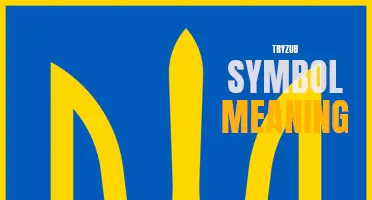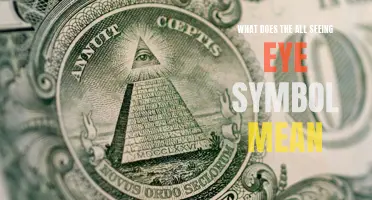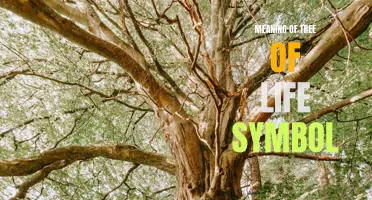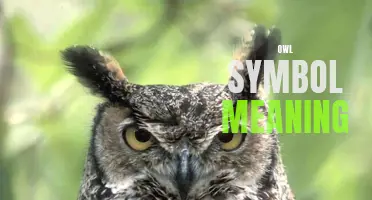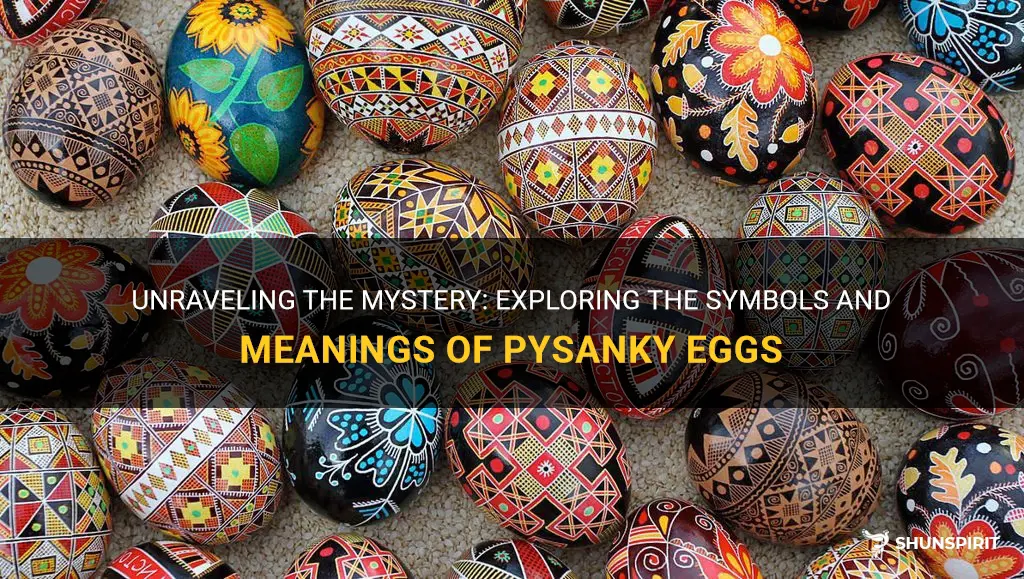
Pysanky, or Ukrainian Easter eggs, are a beautiful and intricate form of traditional Ukrainian folk art. These eggs are created using a wax-resist method, in which intricate designs are drawn on the eggshell with melted beeswax, and then dyed multiple times to create vibrant and striking patterns. Each design and symbol used on the pysanka holds deep cultural and symbolic meaning, representing various aspects of Ukrainian folklore and mythology. From the sun, which signifies life and warmth, to the wheat, symbolizing abundance and fertility, every symbol on a pysanka tells a story and carries centuries of tradition and belief. Exploring the symbols and meanings behind these intricate designs is like delving into a colorful tapestry of Ukrainian culture and history.
What You'll Learn
- What are the most common symbols used in pysanky eggs, and what do they represent?
- Are there any regional variations in the symbols and meanings used in pysanky eggs?
- How have the symbols and meanings of pysanky eggs evolved over time?
- Are there any specific symbols or meanings that hold particular significance or importance in pysanky egg art?
- Can individuals create their own unique symbols and meanings when making pysanky eggs, or is there a set repertoire of symbols that must be used?

What are the most common symbols used in pysanky eggs, and what do they represent?
Pysanky eggs are traditional Ukrainian Easter eggs that are decorated using a wax-resist method and various symbols. Each symbol has a specific meaning and represents different aspects of life, nature, and folklore. Here are some of the most common symbols used in pysanky eggs and their respective meanings:
- Cross: The cross is a powerful Christian symbol and represents faith, spirituality, and the hope of eternal life. It is often found in the center of the egg, symbolizing the life-giving force.
- Sun: The sun is a symbol of brightness, warmth, and fertility. It represents the life-giving power of the sun and the return of spring after the cold winter months.
- Rooster: The rooster is a symbol of good luck and is believed to ward off evil spirits. It also represents the coming of dawn and the resurrection of Christ.
- Fish: The fish is a symbol of Christianity and represents Christ. It is a reference to the story of Jesus multiplying the loaves and fishes.
- Tree of Life: The tree of life is a common symbol found in many cultures and represents the connection between heaven, earth, and the underworld. It symbolizes growth, renewal, and the interdependence of all living things.
- Geometric Patterns: Geometric patterns, such as triangles, diamonds, and squares, are commonly used in pysanky eggs. They represent different elements of nature, such as water, earth, and fire. These patterns also symbolize balance, harmony, and the cyclical nature of life.
- Birds: Birds symbolize the connection between humans and the spiritual world. They represent freedom, peace, and the soul's journey after death. Different birds have different meanings; for example, the dove symbolizes peace and the owl represents wisdom.
- Flowers: Flowers symbolize beauty, fertility, and growth. They represent the rebirth of nature in the spring and the cycle of life. Different flowers have different meanings; for example, lilies signify purity and roses represent love.
- Spirals: Spirals symbolize the endless cycle of life, death, and rebirth. They represent the eternal nature of the soul and the interconnectedness of all things.
- Wheat: Wheat is a symbol of abundance, prosperity, and the harvest. It represents the fertility of the land and the importance of agriculture in Ukrainian culture.
These are just a few examples of the symbols commonly found in pysanky eggs. Each symbol is rich in meaning and adds depth to the intricate designs found on these traditional Ukrainian Easter eggs. The art of pysanky allows individuals to express their beliefs, hopes, and cultural heritage through these vibrant and meaningful symbols.
Understanding Massey Ferguson Tractor Dashboard Symbols and Meanings
You may want to see also

Are there any regional variations in the symbols and meanings used in pysanky eggs?
Pysanky eggs are a traditional form of Ukrainian art that involves decorating eggs with intricate designs using wax and dye. Each symbol and color used in the designs has a unique meaning and significance. While there are some common symbols and meanings that are widely recognized across Ukraine, there can also be regional variations in the symbols and meanings used in pysanky eggs.
The symbols and meanings used in pysanky eggs are deeply rooted in Ukrainian folklore and mythology. They often represent wishes for fertility, prosperity, protection, and good fortune. Some common symbols include the sun, which represents life and warmth; the tree of life, which symbolizes longevity and continuity; and the cross, which represents faith and divine protection.
In addition to these common symbols, there are also regional variations in the symbols and meanings used in pysanky eggs. For example, in some regions of Ukraine, the horse is a popular symbol that signifies strength and power. In other regions, the fish is a common symbol that represents abundance and good luck.
The colors used in pysanky eggs also have symbolic meanings. In general, red is associated with the joy of life, while yellow represents fertility and wealth. Green symbolizes spring and new beginnings, while blue represents good health and spirituality. However, the specific meanings of colors can vary slightly between regions.
One region in Ukraine where there are significant variations in the symbols and meanings used in pysanky eggs is Hutsulshchyna, a mountainous region in the Carpathian Mountains. In Hutsulshchyna, the symbols used in pysanky eggs often depict elements of nature, such as flowers, birds, and animals. These symbols have deep connections to the region's rich folk traditions and reflect the close relationship between the Hutsul people and their surroundings.
In Hutsulshchyna, you may also find unique symbols that are not commonly seen in other parts of Ukraine. For example, the pine tree is a popular symbol in this region, representing resilience and strength. The deer is another common symbol, symbolizing grace and gentleness.
In conclusion, while there are some common symbols and meanings used in pysanky eggs that are widely recognized across Ukraine, there can also be regional variations in these symbols and meanings. These regional variations are a reflection of the diverse cultural traditions and folklore found throughout Ukraine. Whether you are admiring pysanky eggs from Hutsulshchyna or another region, each egg is a unique work of art that tells a story and carries deep symbolic meaning.
Decoding Caterpillar Warning Symbols: What Do They Mean and How to Respond
You may want to see also

How have the symbols and meanings of pysanky eggs evolved over time?
Pysanky eggs are a traditional Ukrainian art form that holds immense cultural and historical significance. These hand-decorated eggs have been created for centuries, and the symbols and meanings behind them have evolved over time.
The practice of creating pysanky eggs dates back to ancient times when Ukrainians worshipped pagan deities. The process involved applying wax patterns onto the eggs and dyeing them with natural ingredients to create intricate and colorful designs. These eggs were considered sacred and believed to possess magical powers.
With the introduction of Christianity to Ukraine in the 10th century, the symbolism behind pysanky eggs changed. The eggs became associated with Easter and the resurrection of Jesus Christ. The wax patterns were now used to tell biblical stories and depict religious symbols such as crosses, angels, doves, and lilies.
Over time, the meaning and symbolism of pysanky eggs expanded beyond religious significance. The eggs began to represent various aspects of life, nature, and folklore. Each region in Ukraine developed its own unique patterns and symbols, often inspired by local customs and beliefs. For example, in Western Ukraine, the Hutsul region incorporates geometric patterns and symbols related to nature, while the Podillya region focuses on floral motifs and symbols of fertility.
In addition to regional variations, different colors and patterns on pysanky eggs carry specific meanings. For instance, red represents life, love, and passion, while black symbolizes death and protection from evil spirits. Yellow signifies fertility and wealth, and green represents growth and harmony. Other colors like blue, orange, and white have their unique meanings as well.
The evolution of technology has also impacted the symbolism of pysanky eggs. With the invention of electric kistkas (a tool used to apply wax), artists can now create more intricate designs and explore new techniques. The use of artificial dyes has also expanded the range of colors and combinations possible on the eggs.
Today, pysanky eggs continue to be an integral part of Ukrainian culture and are celebrated as a symbol of heritage and national identity. They are still created using traditional methods, passed down through generations, and are often displayed during religious holidays and folk festivals. Pysanky workshops and classes are also organized to teach the art to younger generations and promote its preservation.
In conclusion, the symbols and meanings of pysanky eggs have evolved over time, influenced by religious, cultural, and regional factors. From their pagan origins to their association with Easter and Christian symbolism, these intricately decorated eggs have become a representation of Ukrainian heritage and pride. The ongoing exploration and innovation in creating pysanky eggs ensure that this beautiful art form will continue to thrive and be appreciated for years to come.
Exploring the Fascinating World of Moroccan Symbols and Their Deep Meanings
You may want to see also

Are there any specific symbols or meanings that hold particular significance or importance in pysanky egg art?
Pysanky, or Ukrainian Easter eggs, are one of the most cherished and popular forms of traditional Ukrainian folk art. These intricately decorated eggs are created using a wax-resist method, where designs are drawn onto the eggshell with melted beeswax and then dyed in multiple colors. While each design is unique and personal to the artist, there are several symbols and meanings that hold particular significance in pysanky egg art.
One of the most commonly used symbols in pysanky is the triangle. This shape represents the holy trinity in Christianity, symbolizing the Father, Son, and Holy Spirit. The triangle can also represent fire, the sun, and the three sides of the family: parents, children, and grandparents.
Another important symbol in pysanky is the cross. This symbol holds deep religious meaning and is often placed at the top or bottom of the egg. The cross represents the crucifixion of Christ and the victory of life over death. It is a powerful symbol of faith, protection, and hope.
The sun is another commonly used symbol in pysanky egg art. It represents life, warmth, and fertility. The sun is often depicted as a circle with radiating lines, symbolizing the rays of the sun. The sun is also associated with the solar deity and is believed to have healing and purifying powers.
Stars are often seen in pysanky egg art as well. These symbols represent the heavens, guidance, and protection. They can also symbolize the light of Christ and the eternal promise of salvation. Stars are often depicted as six-pointed or eight-pointed, with each point representing a different virtue or quality.
Plants and flowers are also commonly found in pysanky designs. Each plant and flower holds a specific meaning and symbolism. For example, wheat represents a bountiful harvest and prosperity, while ferns symbolize youth and eternal life. Poppies are often used to represent sleep, rest, and peace, while lilies symbolize purity and virtue.
Lastly, animals and mythical creatures are often depicted in pysanky egg art. These symbols can represent various qualities and attributes. For example, the horse is a symbol of power, strength, and fertility, while the rooster symbolizes vigilance and courage. The fish is often used to represent Christianity, abundance, and fertility.
In conclusion, pysanky egg art is not only a beautiful and intricate form of decoration but also deeply symbolic. Each symbol used in pysanky holds a specific meaning and significance, often rooted in Ukrainian folklore, religion, and cultural traditions. The use of these symbols adds depth and richness to the art form, making each pysanka a unique and meaningful piece of art.
The Deep Meaning Behind Huichol Symbols: A Fascinating Exploration of Huichol Culture
You may want to see also

Can individuals create their own unique symbols and meanings when making pysanky eggs, or is there a set repertoire of symbols that must be used?
Pysanky eggs are a traditional form of Ukrainian folk art, where intricate designs and symbols are hand-drawn on eggs using a wax-resist method. Each symbol holds its own significance and meaning, representing various aspects of the culture, nature, and spirituality. While there is a set repertoire of symbols commonly used in pysanky eggs, individuals can also create their own unique symbols and meanings, adding a personal touch to their creations.
The traditional symbols used in pysanky eggs have been passed down through generations, with many of them having roots in ancient pagan beliefs and Christian symbolism. These symbols often include animals, plants, geometric shapes, and religious motifs. For example, a spiral represents eternity and infinity, while a cross signifies faith and protection. The symbols are carefully chosen to convey specific messages and blessings.
However, within the traditional repertoire, there is room for individual creativity and interpretation. Pysanky artists can incorporate their own symbols and meanings, adding a personal touch to their designs. This allows them to express their own beliefs, experiences, or aspirations through their artwork. These unique symbols can be anything that holds personal significance to the artist, ranging from family crests to abstract shapes that represent specific emotions or ideas.
In addition to personal symbols, artists can also modify traditional symbols or combine them in new ways to create unique designs. This allows for endless possibilities and variations in the final appearance of a pysanky egg. The process of creating these symbols and designs requires careful thought and planning, as each stroke of wax and layer of dye contributes to the overall meaning and aesthetic of the egg.
While the traditional symbols and meanings form the foundation of pysanky art, the ability to create one's own symbols and meanings allows for personal expression and artistic innovation. It encourages artists to explore their own creativity and incorporate their unique perspectives into their artwork. This flexibility in symbol creation also ensures that the tradition of pysanky remains alive and relevant in modern times.
In conclusion, individuals can indeed create their own unique symbols and meanings when making pysanky eggs. While there is a set repertoire of traditional symbols commonly used in pysanky art, artists have the freedom to incorporate personal symbols, modify existing symbols, or create entirely new symbols. This artistic flexibility allows for personal expression and ensures that the tradition of pysanky remains vibrant and meaningful for generations to come.
Decoding the Meaning Behind Mickey's Beer Cap Symbols
You may want to see also
Frequently asked questions
Some of the most common symbols used in pysanky include the sun, which represents life and good fortune; the triangle, which symbolizes the Holy Trinity; and the cross, which symbolizes faith and Christianity. Other common symbols include birds, which represent happiness and fertility, and fish, which symbolize abundance and prosperity.
Yes, you can create your own symbols on a pysanka. Pysanky is a unique and personal art form that allows for individual creativity. While it is important to respect and understand traditional symbols and meanings, you can also incorporate your own symbols and meanings into your designs.
Traditionally, pysanky are created using a limited palette of colors, including black, red, white, and yellow. Each color has its own symbolism. For example, black represents protection from evil spirits, red symbolizes the gift of life and the sun, white represents purity and innocence, and yellow symbolizes fertility and wealth. However, modern pysanky artists often use a wider range of colors to create more vibrant and intricate designs.
Yes, it is possible for the same symbol to have different meanings in different cultures. Pysanky is a traditional Ukrainian art form, but similar techniques and symbols can be found in other cultures around the world. While some symbols may have similar meanings across different cultures, others may have unique interpretations and significance. It is important to consider the specific cultural context when interpreting the meanings of symbols in pysanky.


